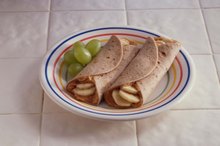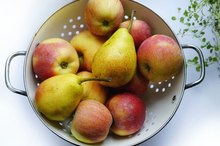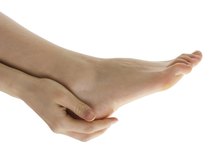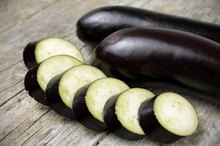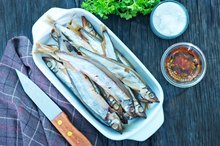If you have gout or kidney stones, you may have to follow a low-purine diet. Purines are compounds found in some foods that are usually excreted in your urine. Sometimes, however, they may build up and crystallize in your joints or form kidney stones.
If you are experiencing serious medical symptoms, seek emergency treatment immediately.
Tips
Following a low-purine diet helps your body to produce less uric acid, which can help manage symptoms of gout, or reduce the risk of uric acid kidney stones. In general, the foods that promote high uric acid include rich or higher-fat meats and seafood, high-fat dairy products and beer.
Purines, Gout and Kidney Stones
**Purines are compounds that are naturally made in your body and also found in some foods.
When your body digests them, they break down into uric acid.
** Most people excrete any excess uric acid in their urine. In some people, however, excess amounts build up in their blood.
When blood levels of uric acid get too high, the excess uric acid can settle in your joints and turn into crystals. **These crystals are actually sharp.
They cause inflammation and a painful type of arthritis known as gout. The American Arthritis Association estimates that gout affects 4 percent of American adults, mostly men 2. **
Following a low-purine diet, which means limiting high-purine foods and eating more anti-inflammatory foods, can help to manage the joint pain and swelling from gout by reducing your high levels of uric acid.
In addition to gout, it’s important to note that in some people, instead of (or in addition to) crystallizing in your joints, the uric acid can crystallize in your kidneys or urinary tract and cause uric acid kidney stones. Like gout, these can be extremely painful, especially when you try to pass a kidney stone.
Eating large amounts of high-purine foods, like meats, fish or animal proteins, increases your risk of uric acid kidney stones, especially if you don’t drink enough fluid to reduce the concentration of minerals in your urine. If you're prone to uric acid kidney stones, following a low-purine diet can help to reduce your risk.
- Purines are compounds that are naturally made in your body and also found in some foods.
- In addition to gout, it’s important to note that in some people, instead of (or in addition to) crystallizing in your joints, the uric acid can crystallize in your kidneys or urinary tract and cause uric acid kidney stones.
Foods Highest in Purine
Foods That Don't Effect Gout
Learn More
Whether you have gout or another condition that requires you to reduce the amount of uric acid in your body, following a low-purine diet or a gout diet can help.
Purine is found in its highest amounts in higher-fat animal protein foods, like rich meats or certain fish. It’s also in some vegetables and legumes, but in much smaller amounts. A gout diet doesn’t require that you cut all of these foods out, but rather, you limit the highest sources of purine you eat at one time.
Most people with gout find it helpful to limit high-purine foods as much as possible. These include:
In addition to the foods on this list, it’s often recommended to avoid foods and beverages that contain high fructose corn syrup. It doesn’t contain purine, but it can increase uric acid levels and prevent you from excreting uric acid as well.
Read more: Foods That Will Eliminate Gout Flareups
- Whether you have gout or another condition that requires you to reduce the amount of uric acid in your body, following a low-purine diet or a gout diet can help.
- A gout diet doesn’t require that you cut all of these foods out, but rather, you limit the highest sources of purine you eat at one time.
Foods to Eat in Moderation
Moderate purine foods are better choices, but try to have small portions and spread these out throughout the day or even better, throughout the week, so you’re not eating too many of these foods all at once:
Most other foods not on this list are considered low-purine foods, and they’re safe to eat on a gout diet. In addition to avoiding high-purine foods, there is some research to suggest that adding certain anti-inflammatory foods may help to reduce uric acid levels.
Anti-inflammatory foods include fatty fish like salmon or sardines, which are high in omega-3 fats, as well as nuts, seeds and most colorful fruits and vegetables. If you try to eat about a half plate of fruits and vegetables at each meal, you'll automatically cut down on purines and reduce uric acid.
- Moderate purine foods are better choices, but try to have small portions and spread these out throughout the day or even better, throughout the week, so you’re not eating too many of these foods all at once: Most other foods not on this list are considered low-purine foods, and they’re safe to eat on a gout diet.
Foods to Lower Uric Acid
3 Types of Fruits Best for People With Gout
Learn More
A study published in the December 2017 journal Critical Reviews in Food Science and Nutrition found that increasing foods that are rich in polyphenols, a type of antioxidant, can help manage uric acid levels. Polyphenols are compounds in plants that protect cells and reduce inflammation. They’re found in foods like berries, grapes, apples, green tea and peanuts.
Read more: 14 Inflammation-Fighting Foods to Eat Every Day
The polyphenols in green tea, in particular, have been studied and found to be helpful in reducing uric acid levels. Researchers who published a study in the December 2015 Journal of Ethnopharmacology noted that green tea polyphenols work by reducing the amount of uric acid produced and increasing the excretion of uric acid. This was an animal study, conducted to help researchers understand more about the way in which green tea works on uric acid, so they can possibly apply recommendations to humans in the future.
Cherries are another food that’s often recommended to reduce inflammation in the body.
They’re packed with antioxidants and anti-inflammatory compounds and can be helpful for arthritis. Research on their role in gout found that eating cherries over a two-day period was associated with a 35 percent lower risk of gout attack/flare.
People who ate cherries in addition to taking medication for gout reported a 75 percent reduction in gout flares. The research was published in the May 2019 issue of Therapeutic Advances in Musculoskeletal Diseases.
- A study published in the December 2017 journal Critical Reviews in Food Science and Nutrition found that increasing foods that are rich in polyphenols, a type of antioxidant, can help manage uric acid levels.
- Read more: 14 Inflammation-Fighting Foods to Eat Every Day The polyphenols in green tea, in particular, have been studied and found to be helpful in reducing uric acid levels.
The Best Gout Diet
If you’re having a hard time putting together a meal plan for yourself, just work on avoiding the high-purine foods, and try to eat a Mediterranean-style diet, which is naturally low in purine. The Mediterranean diet is also associated with many other health benefits so it’s a good choice for everyone.
Read more: Why the Mediterranean Diet is Ranked the Best for 2019
According to a review published in the September 2015 issue of the American Journal of Lifestyle Medicine, the Mediterranean diet is recommended for gout patients because it can prevent high uric acid levels. It tends to be lower in meat and higher in vegetables, fish (just skip the ones on the avoid list) and low-fat diary. All of these foods have anti-inflammatory benefits and can reduce uric acid levels as well as any inflammation associated with your gout.
If your symptoms affect your quality of life, or seem to be getting worse, make sure your talk to your doctor. In addition to these diet changes, there are medications that can help manage gout.
- If you’re having a hard time putting together a meal plan for yourself, just work on avoiding the high-purine foods, and try to eat a Mediterranean-style diet, which is naturally low in purine.
Related Articles
References
- American Academy of Family Physicians: “Low-Purine Diet”
- American Arthritis Association: “Gout”
- Critical Reviews in Food Science and Nutrition: “Management of Hyperuricemia Through Dietary Polyphenols as a Natural Medicament: A Comprehensive Review”
- Journal of Ethnopharmacology: ”Green Tea Polyphenols Decrease Uric Acid Level Through Xanthine Oxidase and Renal Urate Transporters in Hyperuricemic Mice”
- U.S. Department of Health and Human Services and U.S. Department of Agriculture. 2015–2020 Dietary Guidelines for Americans. 8th Edition. Published December 2015.
- U.S. Department of Health and Human Services. Gripped by Gout. NIH News in Health. Published February 2014.
- National Institute of Arthritis and Musculoskeletal and Skin Diseases. Gout. Updated April 2016.
- Zhang Y, Chen C, Choi H, et al. Purine-rich foods intake and recurrent gout attacks. Ann Rheum Dis. 2012; 71(9):1448-53. doi:10.1136/annrheumdis-2011-201215
- Fischer E. Ueber die Harnsauer. 1 [On Uric Acid. 1]. Berichte der Deutschen Chemischen Gesellschaft. 1884: 17:328-338. doi:10.1002/cber.18980310304
- Ragab, G., Elshahaly, M., & Bardin, T. (2017). Gout: An old disease in new perspective – A review. Journal of Advanced Research, 8(5), 495–511. doi:10.1016/j.jare.2017.04.008
- Centers for Disease Control and Prevention. Gout. Updated January 28, 2019.
- Zgaga, L., Theodoratou, E., Kyle, J., Farrington, S. M., Agakov, F., Tenesa, A., … Campbell, H. (2012). The Association of Dietary Intake of Purine-Rich Vegetables, Sugar-Sweetened Beverages and Dairy with Plasma Urate, in a Cross-Sectional Study. PLoS ONE, 7(6), e38123. doi:10.1371/journal.pone.0038123
- Choi HK, Gao X, Curhan G. Vitamin C intake and the risk of gout in men: a prospective study. Arch Intern Med. 2009;169(5):502–507. doi:10.1001/archinternmed.2008.606
- Zhang Y, Neogi T, Chen C, Chaisson C, Hunter DJ, Choi HK. Cherry consumption and decreased risk of recurrent gout attacks. Arthritis Rheum. 2012;64(12):4004–4011. doi:10.1002/art.34677
- Arthritis Foundation. Gout Diet: Dos and Don’ts.
- Boban M, Modun D. Uric acid and antioxidant effects of wine. Croat Med J. 2010;51(1):16–22. doi:10.3325/cmj.2010.51.16
- Caliceti C, Calabria D, Roda A, Cicero AFG. Fructose Intake, Serum Uric Acid, and Cardiometabolic Disorders: A Critical Review. Nutrients. 2017;9(4):395. Published 2017 Apr 18. doi:10.3390/nu9040395
- U.S. Department of Health and Human Services and U.S. Department of Agriculture. 2015–2020 Dietary Guidelines for Americans. 8th Edition. Published December 2015.
- U.S. Department of Health and Human Services. Gripped by Gout. NIH News in Health. Published February 2014.
- Kakutani-Hatayama M, Kadoya M, Okazaki H, et al. Nonpharmacological Management of Gout and Hyperuricemia: Hints for Better Lifestyle. Am J Lifestyle Med. 2015;11(4):321–329. Published 2015 Sep 2. doi:10.1177/1559827615601973
Writer Bio
Anne Danahy is a Boston-based RD/nutritionist who counsels individuals and groups, and writes about healthy eating for wellness and disease management. She holds a Bachelor of Arts from the University of Notre Dame, and a Master of Science in food and nutrition from Framingham State University in Massachusetts.
